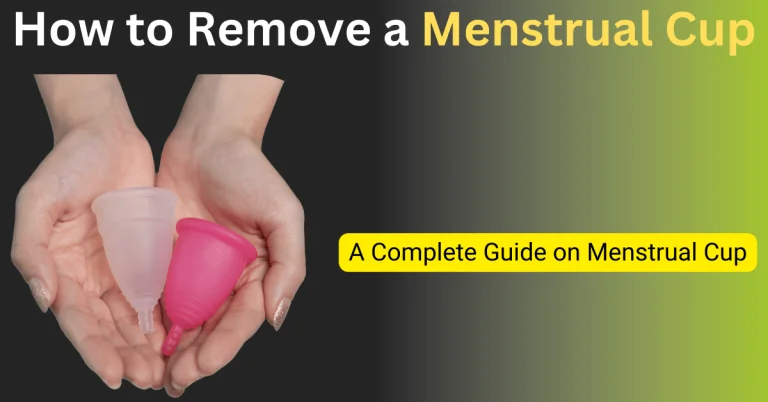Menstrual cup: You’ve heard this term several times, but is a Menstrual cup safe to use? Have you considered the advantages and disadvantages of using a menstrual cup?
How to remove a menstrual cup? Menstrual cup price? How to insert menstrual cups for beginners? This article will go over everything.
Don’t worry; you’ll get all the facts and answers to the most often-asked questions, such as how to use a Menstrual cup, how to insert a menstrual cup?
What is the Menstrual Cup?
The menstruation cup is a reusable feminine hygiene product. A period cup is a small, flexible funnel-shaped cup made of rubber or silicone, used to put into the vagina to trap and collect period fluid.
As blood is shed, the cups catch it rather than absorb it.
Menstrual Cups can store more blood than other techniques. Hence many women prefer tampons as a responsible alternative.
Who Introduced the Menstrual Cup? And when it came into existence?
While it may appear that menstruation cups sprang overnight, they have been in some form since the 1800s.
They were advertised in the 1930s when American actress and singer Leona Chalmers began hawking her patented catamenial receptor, is today known as a menstruation cup.
Currently, more people use menstruation cups as they are Safe and effective.
Menstrual cup sales stalled, but it is assumed by 2026, the global market is estimated to reach $1.89 billion.
Menstrual Cup in India
In 2017 Sirona Hygiene launched a menstrual cup in India.
“It’s been expanding almost 100% year-on-year, but of course, the basis was low,” said founder Deep Bajaj.
Care Form Labs Private Limited, Pune, redesigned Menstrual Cups and introduced it on International Women’s Day, March 8, 2021.
Despite so many perks, you’ll be shocked. India doesn’t recommend Menstrual Cups. Why?
Indian tradition emphasizes a woman’s virginity and the idea that using a cup may cause her to lose it. So, many menstruators avoid cups. Many are afraid of cups since they must be implanted.
According to the fifth National Family Health Survey (NFHS-5), 64.4 percent of Indian women aged 15-24 use sanitary napkins, 49.6 percent use cloth, 15% use made napkins, and 0.3 percent use menstrual cups.
Also Read: How to Maintain Hygiene During Periods
Advantages of Menstrual cup
The following are a few benefits of using menstruation cups that appeal to many women:
- Budget-friendly
- Safe and less waste for trash.
- They can hold more blood.
- They are more eco-friendly than pads or tampons.
- A menstrual cup will dramatically lower leakage risks when inserting it correctly.
- Fewer trips to the pharmacy because they last so long; one menstrual cup can last for up to 2-3 years.
- It can be worn for up to 12 hours, compared to a tampon, for 4 to 8 hours.
- More time changes.
- Useful when engaging in sexual activity
According to a 2012 study, A cup is compatible with an IUD. Menstrual cups can’t remove an IUD, contrary to what some businesses claim, But if you have any concerns, talk to your doctor about wearing a menstrual cup.
- Easy to use
Dr. Higgins thinks anyone who has used tampons, especially those without applicators, can insert a menstrual cup.
- Non-drying as compared to tampons
They are not linked to toxic shock syndrome (TSS), a rare, life-threatening disease related to the use of tampons, according to some rare cases.
- No embarrassing odor
According to A Reliable Source of TSS from menstrual cups, it doesn’t include chemicals like chlorine and dioxin that are present in tampons and pads.
Dr. Higgins believes you can only decide if a menstrual cup will work for you after purchasing and using it for a period
Disadvantages of Menstrual cup
Although eco-friendly and cost-effective, there are a few menstrual cup side effects and downsides to consider before moving to a cup:
- It may be tough to empty and clean.
- It may take some trial and error to get a comfortable fit.
- Finding the proper fit can be difficult.
- Difficulty inserting and removing the menstrual cup
- Allergic reactions to the menstrual cup
- Vaginal discomfort is possible, as are fit issues.
- Sterilize regularly.
Menstrual cups may tug on an intrauterine device (IUD) string or dislodge it. In 2012, this still needed to be proved. Hence some manufacturers tell against using them. Before combining them, see your doctor.
Menstrual cups are safe and comfortable for most people. Yet, a May 2020 research on copper IUDs found that menstruation cups may marginally increase the likelihood of IUD expulsion.
How to use a menstrual cup
How to use a menstrual cup for beginners? The technique for using a menstrual cup is the same for both regular users and newcomers, but some people who have used a tampon may find using the device painful at first.
Yet, with the proper technique and some experience, you can learn how to use a menstrual cup correctly.
- Your age
- The size of your cervix
- Whether your menstrual flow is thick or small,
- The cup’s capacity
- The menstruation cup’s flexibility and firmness
- The strength of your pelvic floor muscles
Find your size first since many feminine hygiene manufacturers provide menstrual cups in different sizes. and you must know how to use the menstrual cup.
If you have any doubts about menstrual cups, discuss them with your gynecologist.
Productivity tip
First-time menstrual cups might be uncomfortable. “Greasing” your cup can make it easier. Before inserting your cup, moisten the rim with water or water-based lubrication (lubricant). Wet menstruation cups are simpler to insert.
Also Read: Pap Smear Test
How to insert a menstrual cup painlessly?
If you can insert a tampon, you should have little trouble with a menstrual cup.
To use a cup, adhere to these steps:
- Sanitize your hands.
- Add a small layer of water or a water-based lubricant on the cup’s rim to simplify insertion.
- Half-fold the menstruation cup. Hold the folded cup in one hand with the rim facing up.
- Put the cup in. It should be placed into your vagina while still folded and with the rim up. Consider inserting the cup as you would use a tampon.
- Rotate it, turn the cup once it is inserted and a few inches below your cervix so that it opens. You shouldn’t be able to feel it if you didn’t insert it.
Also, you could move, hop, swim, sit, stand, and perform other commonplace tasks without worrying about your cup spilling. See your doctor if you’re experiencing problems inserting your cup.
Also Read: Simple and Natural Ways to Tighten Your Vagina
How to remove a menstrual cup painlessly?
Are you ready to remove the cup? Here’s the procedure.
1. Sanitize your hands.
2. Reach inside your vagina and pinch the cup with your thumb and index finger. Then, take the cup out. By breaking the seal, you’ll make it simpler to take off. To remove, gently pull downward.
3. Empty cup: After removing it, empty it into the toilet.
4. Wash the cup in clean water and a mild, fragrance-free soap to rinse it. (and wash the toilet also)
5. Reusable menstrual cups must be cleaned and dried before being reinserted into your vagina if you switch to them. To decrease the chance of irritation, You should empty the menstrual cup twice daily.
Reusable menstruation cups can last 6–12 months with proper maintenance. It would be best if you disposed of menstruation cups after use.
You can use a cup throughout your cycle, but heavy flow days may require more frequent changes to prevent leaks. After 12 hours of leaking, remove and rinse your cup.
Frequently Asked Questions
1. What are the types of Menstrual Cups?
Menstrual cups are usually available in small and large sizes; use smaller cups under 30.
More giant cups are best if you are over 30, have heavy periods, or have given birth.
When it comes to menstrual cups, there are two shapes: the tulip-shaped cup (think DivaCup) and the more bottomless, disc-shaped cup (SoftCup, Flex).
It may take some experimenting with both types before deciding which is best for your health, as they each have various benefits.
2. Is a menstrual cup painful?
Once placed correctly, menstrual cups make periods painless. But, using a menstrual cup requires a learning curve, and your first time may be painful.
Conclusion
Before switching, consider the advantages and disadvantages of using a menstrual cup. If you are still hesitant, speak with your gynecologist about your options and whether a menstrual cup is best for you.
We hope this article clears up all your questions about menstrual cups and guides you on How to Remove Menstrual Cups. And how to insert a menstruation cup?




